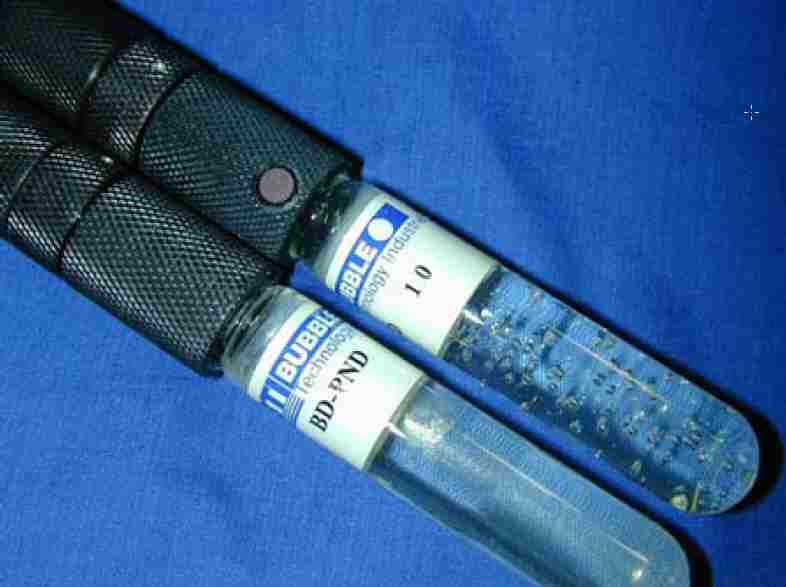Neutron Detectors
Bubble Detectors
Bubble detectors consist of a clear plastic tube filled with a gel polymer. When fast neutrons are incident upon the polymer, they superheat the polymer creating bubbles. These bubbles remain suspended in the gel and may be counted to determine neutron fluence or absorbed dose. Bubble chambers are able to measure both fast and, with the addition of a neutron absorber such as chlorine, thermal neutrons. These features make bubble detectors well suited for in-vault neutron measurements.
Dose Measurement
- Bubble detector cap is unscrewed reducing the chamber pressure and allowing measurement.
- Detector is exposed to neutrons. Neutron interactions superheat the polymer forming bubbles.
- Bubbles are counted either by eye or optically. The number of bubbles is correlated with fluence or absorbed dose.
- Bubble detector is reset by screwing down cap causing the internal pressure to increase.
Advantages
- Useful for in-vault measurements
- Good photon rejection
- Suitable for high dose rate
- No down time
- Small size
- Usable for personnel dosimetry
- Reusable
- Available in various energy ranges from thermal to fast
Disadvantages
- May have strong temperature dependence (5% per C).
- This can be reduced by adding volatile liquid to the chamber whose vapor pressure compensates for temperature sensitivity.
- Bubble overlap makes readout difficult in high dose measurements.
- May lose sensitivity over time due to medium degradation.
Activation Foils
Activation detectors are materials which become radioactive when exposed to neutrons. Determination of neutron absorbed dose is made by measuring decay products of the activation foil (typically β- or γ-rays).
Dose Measurement
- Activation foil is placed in area with neutron presence for set period of time.
- Once exposure is complete, the foil must be taken to a sensitive detector to read out. This is typically done with thin window Geiger counter (for β- emitting foils) or a NaI Crystal or Gi(Li) detector (γ emitting foils).
- Measured foil activity is used to determine neutron fluence or dose.
Types of Activation Foils
Thermal Neutron Detectors
Operate by capturing neutrons, resulting in active daughter nuclide.
Most common detectors are Indium (In-116m, T1/2 = 54 minutes) and gold (Au-198, T1/2 = 2.7 days)
Threshold Activation Detectors
Detectors which require some minimum (threshold) energy to produce the desired reaction. Most often used to measure fast neutron flux.
The most common detector for fast neutron flux around accelerators is Sulfer-32 which has a 2.7MeV threshold for the 32S(n,p)32P reaction.
Moderated Foil Detectors
Another technique for measuring fast neutrons is to surround a thermal neutron detector with a moderator. This reduces the neutron’s energy, allowing detection.
A polyethylene cylinder 15cm in diameter surrounding the foil is used to reduce the fast neutron energy. This cylinder is covered with 0.5-0.8mm of Cadmium which absorbs all incident thermal neutrons. In this way, only fast neutrons are detected.
Advantages
- A variety of materials are available allowing measurement of thermal and fast neutrons.
- Inexpensive allowing many to be used.
- Typically reusable after decay.
- Small allowing for collection of geometric information.
- Collect integrating information.
Disadvantages
- Unwanted activation products can interfere with readout.
- No instantaneous readout.
- Requires additional counting equipment to read out.
- Readout must be performed prior to significant decay.
Navigation
Not a Member?
Sign up today to get access to hundreds of ABR style practice questions.



